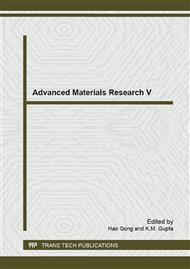p.225
p.231
p.237
p.245
p.253
p.259
p.264
p.269
p.274
Heat Transfer and Pressure Drop in a Pin Fin Heat Sink Using Nanofluids as Coolant
Abstract:
This research presents an experimental investigation on the heat transfer performance and pressure drop characteristics of a heat sink with miniature square pin fin structure using nanofluids as coolant. ZnO-water nanofluids with particle concentrations of 0.2, 0.4 and 0.6 vol.% are used as working fluid and then compared with the data for water-cooled heat sink. Heat sink made from aluminum material with dimension around 28 x 33 x 25 mm (width x length x thickness). The heat transfer area and hydraulic diameter of the each flow channel is designed at 1,565 mm2 and 1.2 mm respectively. Uniform heat flux at the bottom of heat sink is achieved using an electric heater. The experimental data illustrate that the thermal performance of heat sink using nanofluids as coolant is average 14% higher than that of the water-cooled heat sink. For pressure drop, the data show that the pressure drop of nanofluids is a few percent larger than that of the water-cooled heat sink.
Info:
Periodical:
Pages:
253-258
Citation:
Online since:
May 2015
Authors:
Keywords:
Price:
Сopyright:
© 2015 Trans Tech Publications Ltd. All Rights Reserved
Share:
Citation:


